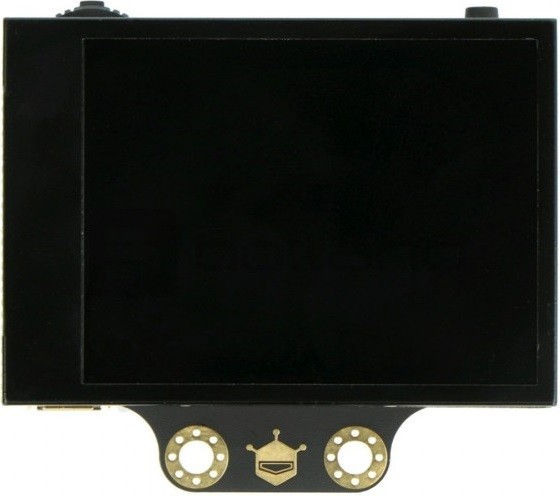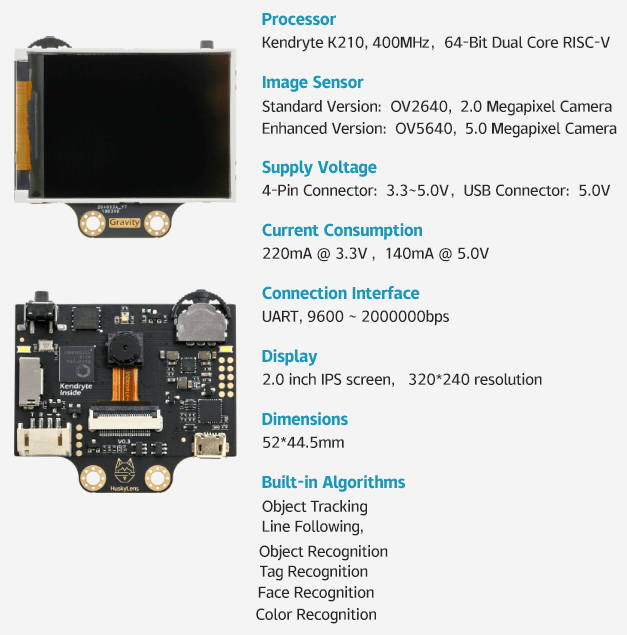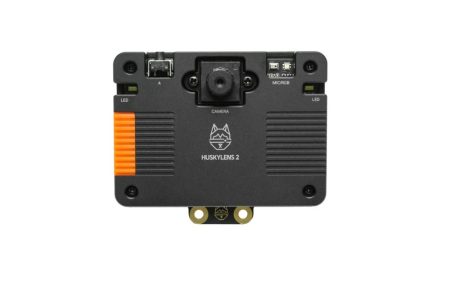HuskyLens AI Vision Sensor
DFRobot has created a low-cost deep learning AI video camera module that is capable of recognizing a wide selection of machine learning algorithms such as objects, faces, tags, QR codes, and colors.
Users can easily change the algorithms using the single button interface. Huskylens can start the learning process while running for the first time. You can connect it with any Microcontroller unit and play around it. This can be very interesting to make projects for the DIY community. It supports the popular micro: bit, Arduino and Raspberry Pi boards, those accelerating and simplifying the development of AI products.
All In One Board: designed for AI And Computer Vision
The HuskyLens cooperate a built new-generation AI chip called Kendryte K210. The main control unit is powered by a Dual-core RISC-V 64bit processor. The clock frequency is 400MHz of this unit. The expected performance of the AI chip can be 1,000 times faster than STM32 when you are going to run a neural network algorithm.
When the object or person appears in front of the camera, it is perceived by the camera, which runs it through the CPU and takes the action you have determined.
In the HuskyLens Pro edition, the module camera is equipped with an improved 5.0-megapixel sensor, against the previous Huskylens 2.0 megapixels. The Huskylens Pro is a faster response device, designed for AI applications that demand higher resolution. It’s constantly being developed more to improve functionality, including software support. It can definitely be used in education institutes for algorithm teaching in robotics DIY projects.


Specifications
- Model: HuskyLens
- Processor: Kendryte K210
- Image Sensor: OV2640 (2.0Megapixel Camera)
- Supply Voltage: 3.3~5.0V
- Current Consumption (TYP): [email protected], [email protected] (face recognition mode; 80% backlight brightness; fill light off)
- Connection Interface: UART, I2C
- Display: 2.0-inch IPS screen with 320*240 resolution
- Built-in Algorithms: Face Recognition, Object Tracking, Object Recognition, Line Tracking, Color Recognition, Tag Recognition
- Dimension: 52mm * 44.5mm / 2.05 x 1.75inch
- Supported Hardware: Arduino, Raspberry Pi, LattePanda, micro: bit

HuskyLens vs HuskyLens PRO
| HuskyLens | HuskyLens PRO | |
| Processor | Kendryte K210 | Kendryte K210 |
| Sensor video | OV2640 2 Mpx | OV5640 5 Mpx |
| Food | 3.3 ~ 5.0 V | 3.3 ~ 5.0 V |
| Current consumption | [email protected] V220mA@ 5.0 V | [email protected] V220mA@ 5.0 V |
| Interfaces | UARTI2C | UARTI2C |
| Function | Face detection Object Color Character recognition recognition To follow objects Following the line | Face detection Object recognition Color Character recognition To follow objects Following the line+ new features are added with the development of the device |
| Supported languages | English Simplified Chinese | English Chinese, traditional Chinese Simplified Chinese new languages will be added in the future |
| Display Size | 2″ | 2″ |
| Type matrix | IPS | IPS |
| Resolution | 320 x 240 px | 320 x 240 px |
| Slow camera (Long transactions)Less resolution camera support system that will limited only to develop functions to from the device | Quick camera work (Faster operation)Higher resolution camera Full support system will be added new functions and languages there are functions to be developed In the future to improve in the direction of the landing itself in device requirements educational |
Price and availability
You can get HuskyLens for $54.90 and there is a range of other options like a protective silicon sleeve worth checking on the DFRobot site.




